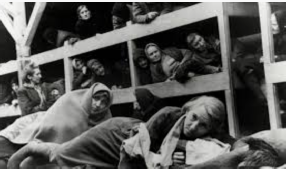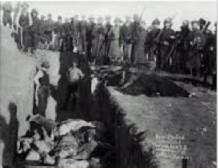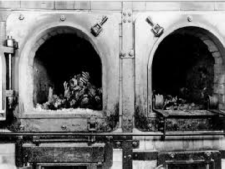|
CLICK BUTTON TO GO |
|
|
|
|
|
|
|
|
|
|
|
|
|
Videos |
|
|
|
|
|
|
|
|
|
|
|
|
|
PART 1 T O P I C |
|
|
|
|
|
|
|
|
|
|
|
|
|
|
|
|
|
|
JewishWikipedia.info
ARTISTS OF TEREZIN:
Guidelines for Educators
Yad Vashem, 2016 (3.52)
(EXCELLENT)
OVERVIEW OF TEREZIN
This video is part of the Holocaust Education Video Toolbox of videos and teaching aids, http://www.yadvashem.org/VideoToolbox.
More than 150,000 Jews passed through Terezin until its liberation in 1945. Of these, over 80% were murdered, either in Terezin
or after deportation to the east.
Many Jews there were prominent
in the fields of culture:
painters, artists, musicians, educators, philosophers and others.
In the video, ISHS staff member Liz Elsby demonstrates how we may use it
teach about the Holocaust.
Liz Elsby is an artist, graphic designer
and guide at Yad Vashem.
THE LAST OF THE UNJUST
Movie Official Trailer 1 (2013) -
Claude Lanzman
Movieclips Film Festivals & Indie Films
2013 (2.07)
PRISONER OF PARADISE
(subtitulos español ) Ricardo VG
2012 (1.35.43)
Prisoner of Paradise is a 2003 Canadian documentary film directed
by Malcolm Clarke and Stuart Sender.
The film tells the true story of Kurt Gerron, a German-Jewish cabaret and film actor in the 1920s and 1930s who was sent to the Theresienstadt concentration camp where he was commanded to write and direct a
Nazi propaganda film
ZDENKA FANTLOVA
DESCRIBES THE MUSIC
OF TEREZÍN CONCENTRATION CAMP
Guardian Music, 2013 (6.44)
At the transit concentration camp of Terezín in the former Czechoslovakia, where some great Czech composers and musicians were imprisoned, music was permitted by the Nazis.
Zdenka Fantlova, who experienced life in the camp, describes what it was like there and how she, unlike many other inmates,
escaped death at Auschwitz
TEREZIN FILM
Hans Krása: BRUNDIBÁR - CHILDREN'S OPERA
BFZBFO 2013 (9.30)
BRUNDIBÁR SURVIVORS
Brundibar & Theresienstadt
Sonicwarhol 2013 (25.50)
HANS KRÁSA’S
CHILDREN’S OPERA BRUNDIBÁR
and
VIKTOR ULLMANN’S
DER KAISER VON ATLANTIS
Cincinnati Chamber Opera presents:
The Theresienstadt Opera Project
2014 (36.34)
BRUNDIBAR REIMS
'illustrateur Reims Frédéric Garcés
2014 (24.05)
BRUNDIBÁR INTRODUCTION AND BRIEF HISTORY
Music and the Holocaust (click link for more detail)
Brundibár is an opera written for children. No more than forty minutes long, it was composed in 1938 by Hans Krása, with lyrics by Adolf Hoffmeister, as an entry for a children’s opera competition. It received its premiere in German-occupied Prague and was performed by children at the Jewish Orphanage in Belgicka Street. Brundibár had one additional performance in the Hagibor building before the mass transports of Bohemian and Moravian Jews to Terezín began in 1942. In July 1943, the score of Brundibár was smuggled into camp, where it was re-orchestrated by Krása for the various instrumentalists who were available to play at that time. The premiere of the Terezín version took place on 23 September 1943 in the hall of the Magdeburg barracks.
Realising the propagandistic potential of this enormously popular artistic endeavour, the Nazis arranged a special new staging of Brundibár for the propaganda film Theresienstadt - eine Dokumentarfilm aus den jüdische Siedlungsgebiet (directed by Kurt Gerron), and the same production was performed for the inspection of Terezín by the International Red Cross in September 1944. This would be the last of the fifty-five performances in the Terezín ghetto; two weeks later, transportation of artists to Auschwitz and other destinations East began, silencing the most popular theatrical production in Terezín.
SYNOPSIS
Aninka and Pepíček, two little children, have a sick mother. The doctor has prescribed milk for her health, and they go to seek it in the town marketplace, but they have no money to purchase it. Three traders hawk their wares: an ice-cream man, a baker and a milkman. The children engage the milkman in song, but he tells them that they need money for milk. Suddenly the children spot the organ-grinder, Brundibár, playing on the street corner. Seeing his success, they decide to busk as well (and proceed to sing a song about geese), much to the annoyance of the townsfolk and Brundibár, who chase them away. Three animals – a sparrow, cat and dog – come to their aid, and together they recruit the other children of the neighbourhood in their plan. Night falls, the dawn comes, the children and animals begin morning exercises and the townsfolk get ready for the day. The plan goes ahead: the animals and children drown out Brundibár; they then join in a beautiful lullaby. The townsfolk are very moved and give Aninka and Pepíček money. Suddenly, Brundibár sneaks in and steals their takings. All the children and the animals give chase and recover the money. The opera concludes with a victory march sung about defeating the evil organ-grinder.
VERDI - REQUIEM
Conducted by Murry Sidlin,
Budapest 2010
ALEX201020102010 1.46.10
At camp Terezin (Theresienstadt), conductor Rafael Schächter formed a choir
of his fellow Jewish prisoners.
Transcending the horrors
around them,
they rehearsed in a cellar,
with a broken piano.
They learned Verdi - Requiem
in Latin which they sang before Red Cross investigators
and SS Officers
PART 1, 14min 21 sec
PART 2 12min 16 sec
VERDI - REQUIEM 2010
Conducted by Murry Sidlin
Mosaic TV Show The Jewish Federation of Palm Beach County,
Hosted by former Federation President Barbara Kay,
Bringing together a soaring live score with visuals and dramatics,
Jocelyn Pook’s ‘Drawing Life’
tells the story of the Terezin concentration camp – a story of the power of creativity and the resilience of the human spirit,
through the words of those held there.
An unlikely hub of creativity, the inmates at Terezin included artists, musicians and academics who encouraged the children to communicate their experiences in the camp through poetry, drawings and music. Orchestras, bands and choirs were formed, performing concerts almost every evening.
Piecing together those poems with music inspired by the stories and visuals that evoke the children’s drawings, this performance composed by Jocelyn Pook
(Eyes Wide Shut, Brick Lane,
Gangs of New York)
in collaboration with director Emma Bernard and video artist Dragan Aleksic manages to take difficult subject matter and unearth uplifting stories of generosity, determination and the spirit of childhood.
JOCELYN POOK’S
‘DRAWING LIFE’
Barbican. London 30 January 2016
Jewish Music Institute (2.46)
To mark the end of
Holocaust Remembrance Week, Benjamin Woolf will lead the
Zemel Choir -
one of the world's finest
mixed voice Jewish Choirs.
‘For us as performers it was heavenly, to know you’d be
performing in the evening, it was
like a word spoken in God’s presence’
Alice Herz-Sommer,
pianist and Terezin survivor
'It is about the human ability to find ways to nourish the spirit even in the harshest conditions. It is about the positive impact of creativity
against all the odds’ –
Jocelyn Pook
It has been selected by the
PRS for Music Foundation
as a winner of the
David Bedford Music Education Award, which recognises
exceptional music education projects involving composers
and new music.
HELGA'S DIARY: A YOUNG GIRL'S ACCOUNT OF LIFE
IN A CONCENTRATION CAMP (TEREZIN) -
Helga Weiss
Matthew Clacher Published on 6 Mar 2013 (10.54)
Helga's Diary is a young girl's remarkable first-hand account of life in a concentration camp during World War II. Like The Diary of Anne Frank this is a publication of international importance and a book that will endure for decades.
In 1938, when her diary begins, Helga is eight years old. Alongside her father and mother and the 45,000 Jews who live in Prague, she endures the Nazi invasion and regime: her father is denied work, schools are closed to her, she and her parents are confined to their flat. Then deportations begin, and her friends and family start to disappear.
In 1941, Helga and her parents are sent to the concentration camp of Terezín, where they live for three years. Here Helga documents their daily life - the harsh conditions, disease and suffering, as well as moments of friendship, creativity and hope - until, in 1944, they are sent to Auschwitz. Helga leaves her diary behind with her uncle, who bricks it into a wall to preserve it.
Helga's father is never heard of again, but miraculously Helga and her mother survive the horrors of Auschwitz, the gruelling transports of the last days of the war, and manage to return to Prague. As Helga writes down her experiences since Terezín, completing the diary, she is fifteen and a half. She is one of only a tiny number of Czech Jews who have survived.
Reconstructed from her original notebooks, which were later retrieved from Terezín, and from the loose-leaf pages on which Helga wrote after the war, the diary is presented here in its entirety, accompanied by an interview with Helga and illustrated with the paintings she made during her time at Terezín. As such, Helga's Diary is one of the most vivid and comprehensive testimonies written during the Holocaust ever to have been recovered.
Helga Weiss was born in Prague in 1929. Her father Otto was employed in the state bank in Prague and her mother Irena was a dressmaker. Of the 15,000 children brought to Terezín and later deported to Auschwitz, only 100 survived the Holocaust. Helga was one of them. On her return to Prague she studied art and has become well known for her paintings. The drawings and paintings that Helga made during her time in Terezín, which accompany this diary, were published in 1998 in the book Draw What You See (Zeichne, was Du siehst). Her father's novel And God saw that it was bad, written during his time in Terezín and which she illustrated, was published in 2010. In 1954 Helga married the musician Jiri Hosek. She has two children, three grandchildren and lives to this day in the flat where she was born.
INSPIRATIONAL PIANIST,
TEREZIN HOLOCAUST SURVIVOR,
ALICE HERZ-SOMMER
- 109 YEARS OLD
TheLadyInNumberSi 2013 (11.23)
The Guardian (23.2.2014)
Alice Herz-Sommer: pianist and oldest known Holocaust survivor
dies aged 110

More information about the
Nazis and Music
Terezin Music Foundation
HOLOCAUST -
VIDEOS and FILMS - TEREZIN (Theresienstadt)



THE
INCREDIBLE
STORY OF THE JEWISH PEOPLE
